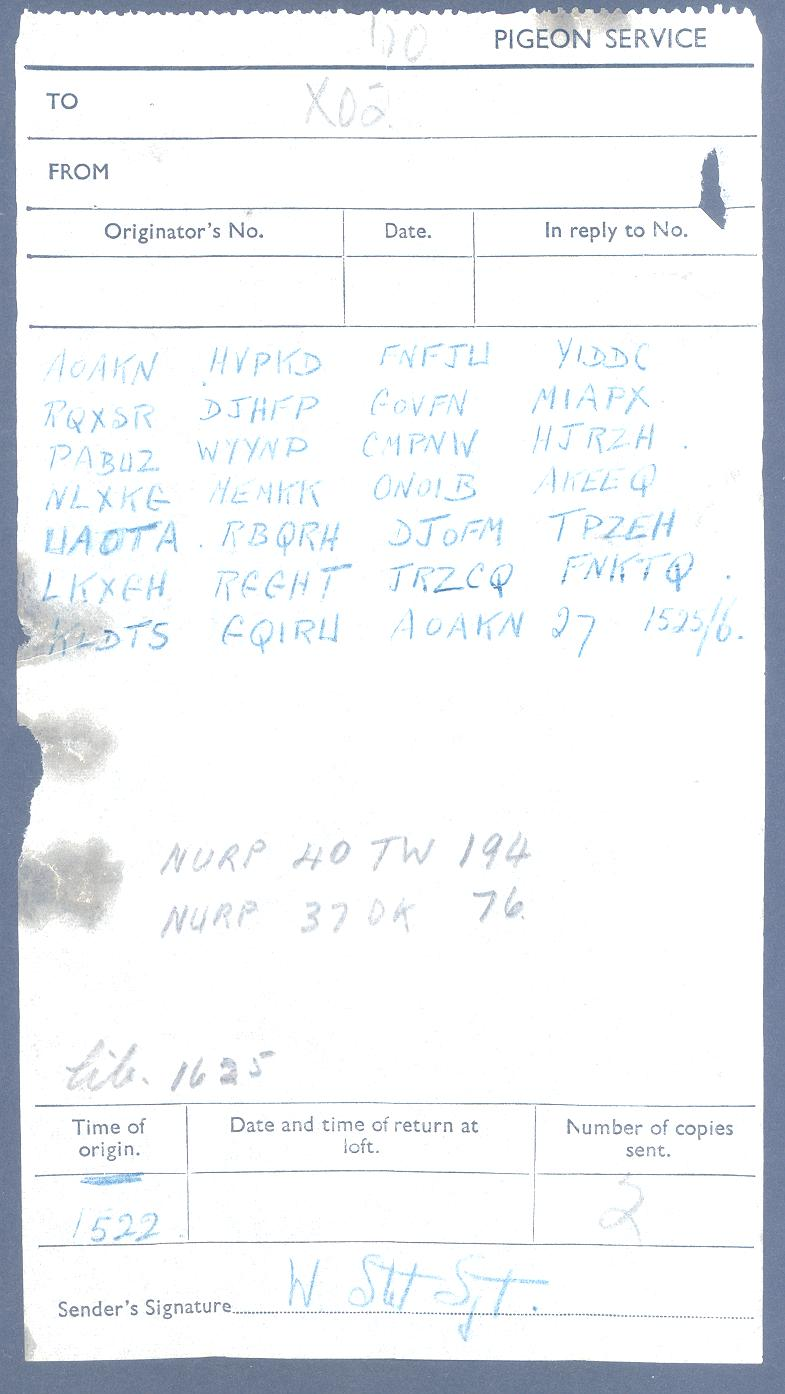Analysis of the WW2 Pigeon Cipher
Background §
A man cleaning his chimney found a dead pigeon with a second World War coded message strapped to its leg: dailymail. GCHQ has made a few statements about how it is unbreakable without further information.
It was claimed that the cipher was broken, but other sources have claimed that the solution is silly, with more analysis here.
The message itself can be seen below:

The cipher transcribed below:
AOAKN HVPKD FNFJU YIDDC RQXSR DJHFP GOVFN MIAPX PABUZ WYYNP CMPNW HJRZH NLXKG MEMKK ONOIB AKEEQ UAOTA RBQRH DJOFM TPZEH LKXGH RGGHT JRZCQ FNKTQ KLDTS GQIRU AOAKN
General observations §
At the bottom of the paper is some writing: lib 1625. This is short for 'liberated 1625' i.e. the pigeon was released at 4:25 pm. This has been written in a different hand to the rest of the message, presumably by the pigeon handler. Additionally, the message says there are 2 copies, and provides 2 pigeon numbers: NURP 37 DK 76 and NURP 40 TW 194. Presumably the pigeon found in the chimney is one of these pigeons. The ciphermysteries blog has a good breakdown of many of these details.
The cipher begins and ends with the indicator AOAKN. The use of a 5 letter indicator may give clues as to the identity of the cipher, since not all ciphers have 5 letter indicators. The cipher ends with the characters 27 1525/6. The 27 matches the number of 5 letter groups. The 1525 is very close to the time given at the bottom of the paper, which may mean it took 3 minutes to encipher the message, since 1525 is 3 minutes after 1522. It has been put forward that the 6 may mean the 6th day of the month. Indeed, if the cipher has a daily key of some sort then the date would presumably be written somewhere on the message. .
Possible ciphers §
Playfair §
For a recap of Playfair see here. Playfair was used by the Australians in the Pacific during WW2, but there is no indication the british used it. In any case, a good set of reasons why it is not playfair is given here. In short: there are an odd number of characters, double letter groups exist, and there are 26 characters in the ciphertext. None of these things are possible for a playfair cipher.
Double Transposition §
Transposition systems as a rule don't modify the monogram frequencies of the plaintext or change the Index of Coincidence. The I.C. of this message is 0.03, which is what you would expect for uniform randomly chosen characters. This makes it unlikely to be scrambled English, which would have an I.C. closer to 0.06. The manual for sending Double Transposition ciphers can be seen over here, and it says that the indicator is a group of 4 digits repeated at the beginning and end of the message. Since this cipher has a 5 letter indicator, not a 4 digit one, it does not seem to be a double transposition.
One Time Pad §
This has been proposed by a few people, but I see it as fairly unlikely. One time pads are very tricky to supply keys for, they can work for secret agents, but not for general use by the army. Since this message was apparently sent by Sgt. Stout on standard issue army stationary, I can't see them using an OTP.
Linex §
The Linex cipher is described here. The indicator for a linex cipher is a 4 character group, however the cipher in question has a 5 letter indicator. The Linex cipher was recommended for use as a replacement to the existing double-transposition cipher by the War Office in 1945. Does this mean it was not used prior to 1945?
Slidex §
Slidex was widely used by the allies, pictures of the device can be seen here. A description of of Slidex can be seen in this paper. An exerpt from the paper:

Could the 6 in 27 1525/6 indicate the Slidex card used?. The paper also doesn't mention what sort of indicator was sent along with the messages. The biggest problem I have with slidex is that slidex was a bigram cipher, and the pigeon message has an odd number of characters. I would say this rules it out effectively.
Typex §
This was a British rotor machine similar to the German Enigma. A description of the Typex machine can be seen in this paper, pictures can be seen here and here. I do not know what the indicator looked like for Typex messages, though there are 5 rotors on the Typex machine, which means an indicator of 5 characters could have been used. Further investigation is required. If anyone has any information about the indicator use in typex messages, please leave a comment!
M-209 §
I am fairly confident in saying it is not an M-209 message, firstly because it was sent by the British, not the Americans. Also, the indicator is wrong. This series of videos explains how to set up the indicator string for M-209 messages.
comments powered by Disqus